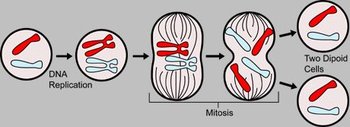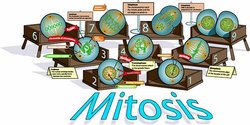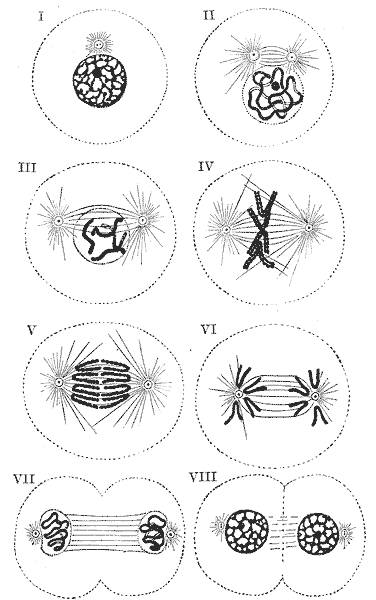Mitosis
|
|
In biology, mitosis is the process of chromosome segregation and nuclear division that follows replication of the genetic material in eukaryotic cells. This process assures that each daughter nucleus receives a complete copy of the organism's genome. In most eukaryotes mitosis is accompanied with cell division or cytokinesis, but there are many exceptions, for instance among the fungi. There is another process called meiosis, which is similar to mitosis in many ways, in which the daughter nuclei receive half the chromosomes of the parent, which is involved in gamete formation and other similar processes.
| Contents |
Overview
Mitosis is divided into several stages, with the remainder of the cell's growth cycle considered interphase. Properly speaking, a typical cell cycle involves a series of stages: G1, the first growth phase; S, where the genetic material is duplicated; G2, the second growth phase; and M, where the nucleus divides through mitosis. Mitosis is divided into prophase, prometaphase, metaphase, anaphase, and telophase.
The whole procedure is very similar among most eukaryotes, with only minor variations. As prokaryotes lack a nucleus and only have a single chromosome with no centromere, they cannot be properly said to undergo mitosis. Instead they undergo what is known as binary fission.
Phases
Prophase
Main article: Prophase
The genetic material (DNA), which normally exists in the form of chromatin condenses into a highly ordered structure called a chromosome. Since the genetic material has been duplicated, there are two identical copies of each chromosome in the cell. Identical chromosomes (called sister chromosomes) are attached to each other at a DNA element present on every chromosome called the centromere. A protein called cohesin acts as a glue joining two sister chromosomes (a.k.a. sister chromatids) along their lengths. When chromosomes are paired up and attached, each individual chromosome in the pair is called a chromatid, while the whole unit (confusingly) is called a chromosome. Just to be even more confusing, when the chromatids separate, they are no longer called chromatids, but are called chromosomes again. The goal of mitosis is to assure that one copy of each sister chromatid — and only one copy — goes to each daughter cell after cell division.
The other important piece of hardware in mitosis is the centriole. Each centrosome contains two centrioles. The two centrosomes of the cell serve as organizing centers for microtubules. During prophase, the two centrosomes — which replicate independently of mitosis — begin recruiting microtubules (which may be thought of as cellular ropes or poles) and forming mitotic spindles. By increasing the length of the spindle (growing the microtubules), the centrioles push apart to opposite ends of the cell nucleus. It should be noted that many eukaryotes, for instance plants, lack centrioles, although the basic process is still similar.
Prometaphase
Main article: Prometaphase
Some biology texts do not include this phase, considering it a part of prophase. In this phase, the nuclear membrane dissolves in some eukaryotes, reforming later once mitosis is complete. This is called open mitosis, found in most multicellular forms. Many protists undergo closed mitosis, in which the nuclear membrane persists throughout.
Now kinetochores begin to form at the centromeres. This is a complex protein structure that may be thought of as an 'eyelet' for the microtubule 'rope' - it is the attaching point by which chromosomes may be secured. The kinetochore is an enormously complex structure that is not yet fully understood. The key feature of a kinetochore is that it contains a molecular motor that uses energy from ATP molecules to move a chromatid along a microtubule, like a train on a train track. Two kinetochores form on each chromosome - one for each chromatid.
When the spindle grows to sufficient length, the microtubules begin searching for kinetochores to attach to.
Metaphase
Main article: Metaphase
As microtubules find and attach to kinetochores, they begin to line up in the middle of the cell. Proper segregation requires that every kinetochore be attached to a microtubule before separation begins. It is thought that unattached kinetochores control this process by generating a signal - the mitotic spindle checkpoint - that tells the cell to wait before proceeding to anaphase. There are many theories as to how this is accomplished, some of them involving the generation of tension when both microtubules are attached to the kinetochore.
When chromosomes are bivalently attached - when both kinetochores are attached to microtubules emanating from each centriole - they line up in the middle of the spindle, forming what is called the metaphase plate. This does not occur in every organism - in some cases chromosomes move back and forth between the centrioles randomly, only roughly lining up along the midline.
Anaphase
Main article: Anaphase
When every kinetochore is attached to a microtubule and the chromosomes have lined up along the middle of the spindle, the cell proceeds to anaphase. This is divided into two phases. First, the proteins that bind the sister chromatids together are cloven, allowing them to separate. They are pulled apart by the microtubules, towards the respective centrioles to which they are attached. Next, the spindle axis elongates, driving the centrioles (and the set of chromosomes to which they are attached) apart to opposite ends of the cell. These two stages are sometimes called 'early' and 'late' anaphase.
At the end of anaphase, the cell has succeeded in separating identical copies of the genetic material into two distinct populations.
Telophase
Main article: Telophase
Daughter chromosomes arrive at poles by this stage. The nuclear membrane reforms around the genetic material and the chromosomes are unfolded back into chromatin. This is often followed by cytokinesis or cleavage, where the cellular membrane pinches off between the two newly separated nuclei, to form two new daughter cells. At this point, each new nucleus contains one copy of each chromosome. Mitosis is complete.
Interphase
Main article: Interphase
Interphase is a phase of the cell cycle, defined only by the absence of cell division. Cells during interphase may or may not be growing. At any given time, even in an area of rapid cell division such as the tip of a plant root, 90 per cent of cells are in interphase. Some cells, such as nerve cells, can stay in interphase for decades. The cell grows and replicates its DNA and centrioles. There are 3 parts of interphase: G1 (growth 1 in which the cell creates organelles and begins metabolism), S phase (DNA synthesis in which the chromosomes of the cell are copied) and G2 (growth 2 in which the cell grows in preparation for cell division).
Endomitosis
Endomitosis is a process that occurs when chromosomal replication takes place without nuclear or cellular division, resulting in cells with many copies of the same chromosome. This process may also be referred to as endoreplication and the cells as endoploid.



